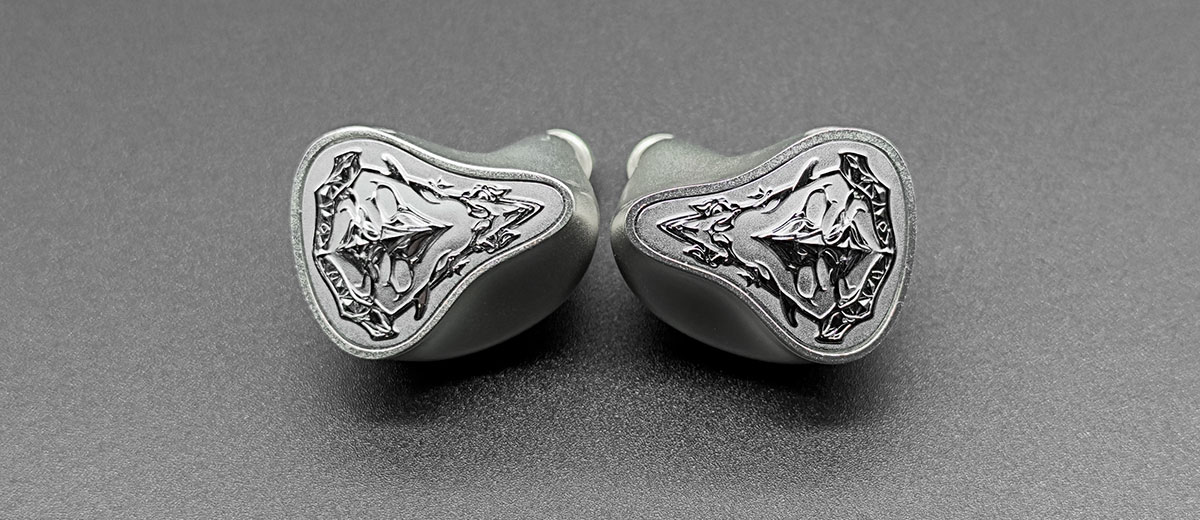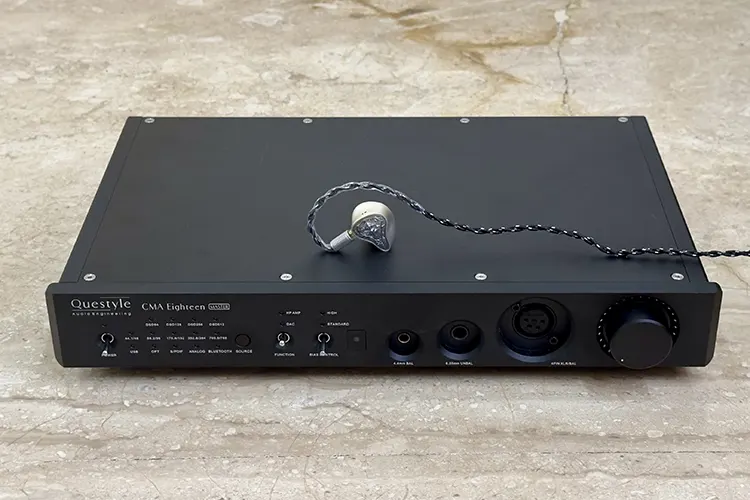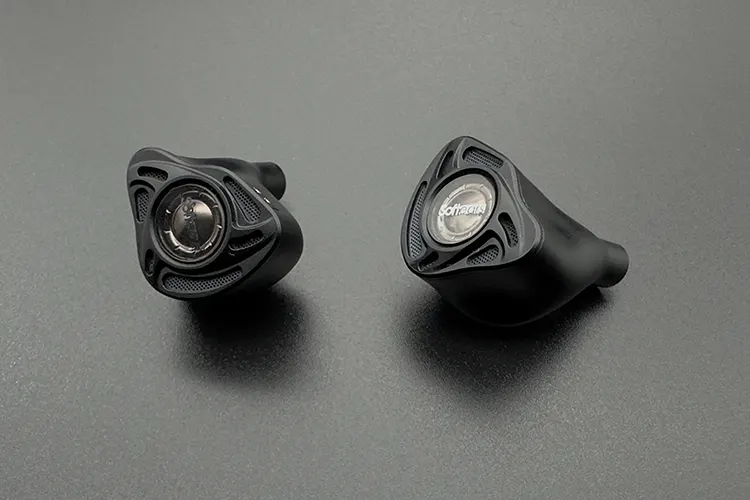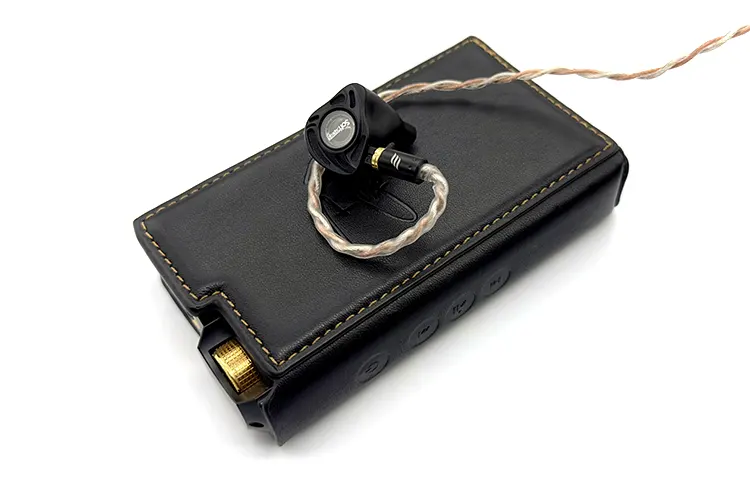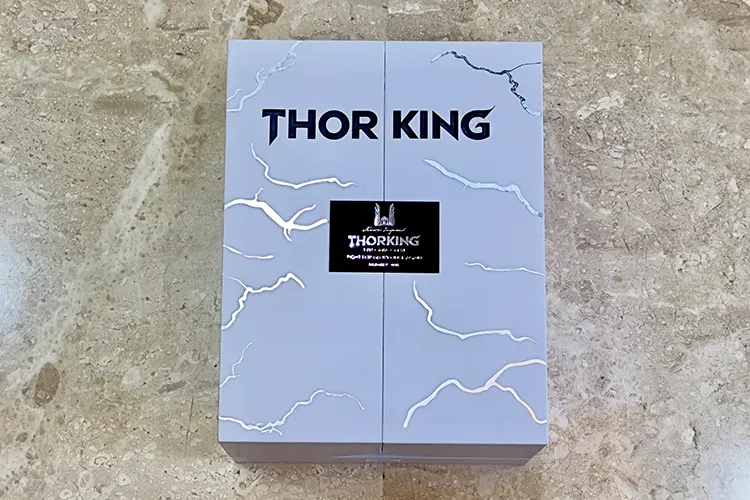Synergy
Efficiency
Kinera ThorKing has an impedance of 10Ω @ 1 kHz and a sensitivity rating of 105 dB/Vrms. The IEM can be comfortably driven by sources with fewer power specifications, such as dongles and smartphones.
From the first look at it, ThorKing does not seem very demanding. But this is one of those IEMs that asks for a very capable source. The better source you pair it with, the more it surprises you.
One key aspect to consider is that better power delivery directly enhances the dynamics and bass response and adds to the openness of sound. Once you’ve paired ThorKing with a capable source, there’s no going back; everything else will sound subpar. That’s just how it is.
Due to its neutral and balanced tuning, I find it pairs best with a warmer and cleaner source, which helps bring out more body and depth. A bright leaning source can make the sound too clinical to be enjoyable.
Source Pairings
The Lotoo Paw Gold Touch offers a decent amount of power, which opens up the ThorKing, giving it a slightly lush and fuller presentation.
This IEMs benefit in the low end, resulting in a decent bass range. The midrange remains very detailed and natural. The lower midrange is lean and weightless.
The treble region is a bit sharp but not overly exaggerated. The overall stage presentation is holographic, though it does not stretch too wide. The depth in the soundstage is commendable, offering a satisfying sense of distance and layering between different instruments.
Astell&Kern SP3000 stuns with its massive soundstage. With ThorKing, the presentation is more expansive than on LPGT. The separation of instruments and imaging aspects is significantly better.
The timbre is cleaner and more incisive without veering into too much sharpness. The lower end is a bit more controlled and has better layering.
I prefer the midrange on LPGT, as it feels more natural and has an extra sweetness. The treble on the SP3000 is airier and more detailed. I prefer the SP3000 for genres like electronic, dance, and metal, while LPGT does better justice to vocal-centric genres.
Though I don’t recommend using desktop systems for IEMs, I’m always curious about how the CMA18M pairs with flagship IEMs to explore their full potential.
The low end here is a bit more spread out, but the impact is tighter and deeper than on the other sources. This is because of the better dynamics the massive power brings in.
The midrange is rich and full, delivering powerful vocals with a slight forwardness. The notes are taller and a bit denser.
Treble notes are taller and weightier, making them feel less sharp, more refined, and smoother. The stage presentation is more holographic with better depth than the SP3000.
Select Comparisons
LETSHUOER Cadenza12 2024 Edition
Technical
LETSHUOER Cadenza 12 2024 is a universal in-ear monitor featuring a 12-driver setup, including one dynamic driver and 11 balanced armatures, with a mix of Sonion and Knowles drivers and a 6-way crossover.
Cadenza 12 has an impedance of 16Ω @ 1 kHz and a sensitivity rating of 110 dB/Vrms. Even if the Cadeza12 does not demand additional power, it does benefit from a powerful source.
Like the ThorKing, it can scale a bit, as with added power, I find the stage expanding a bit with better separation and an added sense of openness.
Design
The shells of the Cadenza 12 are made from titanium alloy, whereas the ThorKing features brass shells. The Cadenza 12 is ergonomically designed with smooth edges, so despite its heavier shells, the fit remains comfortable.
I prefer the matte finish of the ThorKing, as the mirror-like finish of the Cadenza 12 is prone to scratches, making it more high maintenance.
Both IEMs offer a premium unboxing experience with a well-curated selection of accessories. The ThorKing has a better ear tip selection, while I prefer the Cadenza 12’s carry case design, though it feels a bit cramped.
Both IEMs use standard 2-pin 0.78mm connectors. Additionally, the modular stock cable on the Cadenza 12 is more rugged compared to the ThorKing’s balanced cable.
Performance
The newer version of the LETSHUOER Cadenza 12, with its more balanced tuning, comes quite close to the ThorKing’s.
Both IEMs feature a slightly V-shaped sound signature. Cadenza 12 utilizes a more impactful bass range and fuller midrange, while ThorKing prioritizes the treble region and resolution.
Both have a similar low-end profile with a humble impact, though the Cadenza 12 takes the lead with its more detailed and better-textured bass.
In the sub-bass and mid-bass regions, the Cadenza 12 has more impact, though ThorKing is not far behind. ThorKing’s has a tight and precise bass with enough quantity to complement its balanced overall tuning.
In the lower midrange, the Cadenza 12 has a bit more body and thickness, resulting in a fuller, lusher sound compared to the ThorKing. The Cadenza 12 is the warmer of the two, while ThorKing excels in detail, offering a clearer midrange presentation.
Both IEMs provide a natural and realistic midrange with authentic vocals, though the ThorKing has better upper-midrange extension. Vocals are denser and more prominent on the Cadenza 12.
ThorKing offers slightly better resolution and airiness compared to the LETSHUOER Cadenza 12. Its treble is airier, with more sparkle and shimmer, and it outperforms in accuracy and precision.
For instance, cymbal crashes are more distinctly rendered, with superior separation and resolution of multiple crashes on the ThorKing. The Cadenza 12 has extra emphasis in the lower treble, making it slightly sharper on certain tracks.
For staging, the ThorKing has a slight edge, providing more depth and width. Its cleaner timbre, refined treble, and greater airiness create a better sense of openness.
Instrument separation is more defined, and micro-details are more prominent on the ThorKing, making it the slightly more detailed option. Imaging is more accurate and precise on the ThorKing.
Nostalgia Audio NA12
Technical
The NA12 is a studio reference IEM from the house of Nostalgia Audio. NA12 features 12 drivers, incorporating 8 proprietary balanced armature drivers, dual electrostatic drivers, and a Sonion dual-membrane bone conduction vibrator. There is a 6-way crossover implementation.
The dual-bone conduction drivers are specifically tuned for the midrange frequencies, helping the vocals achieve better clarity and precision.
The NA12 is rated at 116 dB @ 1 kHz, 1 mW, and an impedance of 18Ω @ 1 kHz, making it as easy to drive as the ThorKing.
I do not find the NA12 scaling much, and it does not demand powerful sources. On my LPGT, ThorKing takes up nearly 5-7 extra volume clicks.
Design
The shells of the NA12 are crafted from resin and feature a deep red, single-tone color with a slightly transparent finish. The shells are a bit larger than that of ThorKing’s.
The metal shell and a very plush design make ThorKing quite a looker. For my ears, the ThorKing has a better fit as the NA12 has larger nozzles.
Both IEMs use standard 2-pin 0.78mm connectors. The NA12 is offered with two cables, one of which is a 3.5mm cable designed for studio monitoring, and the other one is a more premium 4.4mm high-purity silver-plated cable, which I prefer.
In comparison, the ThorKing’s stock cable is thicker but not any better in terms of performance.
Though NA12 does not have grand packaging, the accessories included are top-notch. I love the sturdy aluminum carry case that comes with the NA12 over the carry case of the ThorKing’s.
The ear tips included with the NA12 are of better quality, especially the XWB ear tips, which have become my go-to choice.
Performance
Even though the NA12 is labelled as a reference-grade IEM, I find ThorKing to have more true-to-reference tuning.
The NA12 leans toward a warmer and thicker presentation, while the ThorKing cuts the warmth and prioritizes clarity and a cleaner timbre. ThorKing delivers faster transients with crisp, well-defined attacks and decays, whereas the NA12 feels a bit sluggish.
The NA12 has a thicker bass range but lacks the control and tightness that the ThorKing has. It’s a trade-off between quantity and quality. ThorKing offers good texture and layering, but it lacks impact by some margin, which makes the NA12’s bass more satisfying.
In the midrange, the NA12 is more musical, with greater warmth and a fuller presentation compared to the ThorKing’s drier, less-immersive midrange.
The NA12’s midrange is more forward, bringing vocals closer to the ears. Its lower midrange has more body and density, which ThorKing lacks, making vocals and instruments sound lean and thin.
Notes on the NA12 are taller and carry more weight, making the midrange appear larger and more lifelike. The BCD driver on NA12 adds a touch of vibrancy to the midrange, making it more enjoyable.
In the treble region, the ThorKing does a much better job, offering more air and sparkle in the upper frequencies. The NA12 keeps treble more restrained, causing it to miss a few details that the ThorKing easily picks up.
The treble notes on the ThorKing have better decay and resolution. The NA12 is noticeably smoother, while the ThorKing’s treble remains non-fatiguing.
Technically, I find ThorKing leading with a more resolving and detailed presentation. Its soundstage stretches wider, though the NA12 has better depth and greater vertical height. Imaging and layering are superior on the ThorKing, producing more precise and detailed spatial cues.
Softears Enigma
Technical
The Softears Enigma is a tribrid multi-driver IEM equipped with dual dynamic drivers, six custom-balanced armature drivers, and four Sonion electrostatic drivers.
For the lows, the Enigma uses a mix of an active 10mm dynamic driver with 2 additional BA drivers. There is also a second beryllium-coated diaphragm dynamic driver deployed in a passive mode.
The midrange frequencies are handled by four full-range custom-balanced armature drivers, and for the high,s there are four Sonion electrostatic drivers. There is a 5-way electronic crossover and a 4-way physical crossover implemented.
The Enigma has an impedance of 10Ω @ 1 kHz and a sensitivity rating of 121.5 dB/Vrms, making it easily driven by lower-power sources like dongles and smartphones.
Like the ThorKing, it shines a lot when paired with some powerful sources. On my LPGT, Enigma takes fewer volume clicks than ThorKing.
Design
The Enigma has a futuristic look, with cutouts on the faceplate resembling a rotating disc and a round, artificial sapphire-like crystal in the center.
The shell, crafted from an aluminum alloy, feels as durable as ThorKing’s. Enigma is a bit larger than ThorKing, but both fit quite well. Kinera and Softears have aced the design, making it tough to decide which one I prefer.
Enigma offers one of the most intriguing and unique unboxing experiences, packed with high-quality accessories that cover almost everything one could look for. Considering the price difference between the two IEMs, ThorKing has also done an excellent job.
Both IEMs use the same 0.78mm 2-pin connector. The custom-designed stock Effect Audio balanced cable on Enigma feels more premium than ThorKing’s.
The 4-wire configuration combines two wires of 7-strand, 24AWG silver-gold-plated and silver-enameled material with two wires of fine silver and fine copper.
In addition to this, a single-ended cable is also included. Enigma’s carrying case is much bigger, providing ample space for storing the IEMs.
Performance
ThorKing focuses on a razor-sharp presentation with sparkly, airier highs, compromising some sweetness in the midrange. Enigma, on the other hand, balances its tuning without emphasizing any particular frequency region.
Imagine ThorKing’s bass quality but amplified a few levels; that’s Enigma’s bass. Enigma delivers greater quantity, a deep and textured sub-bass, and a punchy mid-bass.
ThorKing’s bass lacks impact and depth, coming across as much leaner than Enigma’s dense and impactful bass. I wish Enigma’s bass was tighter, but I love every bit of it.
It’s tough to compete with Softears’ special sauce, which gives the midrange a musical touch with minimal coloration. ThorKing focuses on a clean and sharp midrange with an emphasis on detail and resolution.
Enigma’s midrange is more lifelike and engaging, providing ample thickness to vocals and instruments. In the upper midrange region, ThorKing is a touch sharper and throws out too much detail, which can be fatiguing.
In the treble region, ThorKing is airier and has more sparkle. The upper frequencies are extremely crisp, highly detailed, and sharply defined, though they can sometimes feel intense or fatiguing.
Switching between both IEMs, I noticed a stark difference in presentation. Enigma is smooth and free from exaggeration, yet highly detailed, preserving most nuances effortlessly.
While ThorKing takes a technical-first approach, Enigma stumps it with its humongous soundstage. The stage on Enigma stretches wide across all dimensions, creating a very holographic presentation.
ThorKing does well in width but falters in depth and vertical height. Both IEMs separate instruments well and handle complex tracks easily, but Enigma does it better due to its more expansive soundstage.
ThorKing delivers sharp and precise details, sometimes feeling aggressive, while Enigma is smoother but still detailed.
My Verdict
For me, the Kinera ThorKing is a unique IEM that stands apart from the usual offerings. I’ve seen plenty of basshead IEMs that impress bass lovers with their deep lows, but ThorKing caters to treble lovers instead.
With its unapologetically treble-first reference tuning, the ThorKing delivers an airy, sparkly, and highly detailed set of highs that will thrill treble lovers. The technical performance is on par with its peers.
However, all this comes with some trade-offs. The bass shelf is lean, lacking strong impact, though it can kick in when needed. The midrange, due to its ultra-clean timbre, loses some warmth and sweetness.
A bit more heft in the bass and lower midrange could have balanced things out. ThorKing shines with powerful sources, adding the right weight to notes and smoothing out treble regions, so be sure to try some.
Overall, ThorKing stands as a bold attempt from the team at Kinera. Mind you, once you experience this level of clean tuning and detailing, moving back to a warmer sound signature may feel overly colored.
On top of everything, the premium look of ThorKing is striking. I thoroughly enjoyed my time with the ThorKing and hope it receives the appreciation it deserves from the community.
Kinera ThorKing Specifications
- Driver Configurations: 1 DD + 6 Knowles BA + 4 Sonion EST.
- Frequency Response: 5 Hz – 50 kHz
- Impedance: 10 Ω.
- Sensitivity: 105 dB.
- Cable: 7 NN OCC, 26 AWG (2-pin, 4.4mm Balanced only)
- Cable length: 1.2 m




